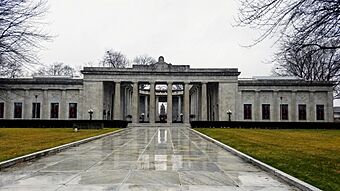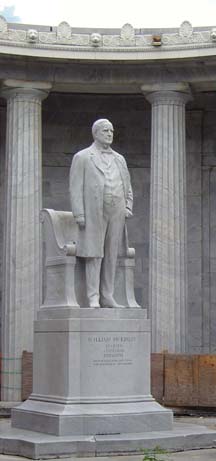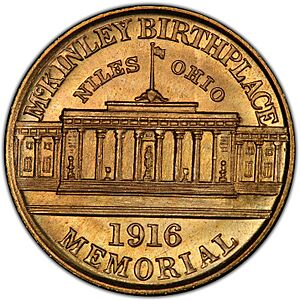National McKinley Birthplace Memorial facts for kids
Quick facts for kids |
|
|
National McKinley Birthplace Memorial
|
|

The memorial in 2019
|
|
| Location | 40 N. Main Street Niles, Ohio |
|---|---|
| Area | Less than one acre |
| Built | 1915 |
| Architect | McKim, Mead and White |
| Architectural style | Beaux-Arts (exterior) |
| NRHP reference No. | 75001544 |
| Added to NRHP | October 31, 1975 |
The National McKinley Birthplace Memorial is a special building in Niles, Ohio. It honors William McKinley, who was the 25th President of the United States. This big marble building is also known as the McKinley Memorial Library, Museum & Birthplace Home. It has two main parts, called wings.
One wing holds the McKinley Memorial Library, which is a public library. The other wing has the McKinley Museum. Here, you can see cool exhibits about President McKinley's life. There's also an auditorium for events.
Close by, at 40 South Main Street, is the McKinley Birthplace Home and Research Center. This historic house museum shows what a home looked like when President McKinley was in office.
Contents
Building the Memorial
How the Idea Started
On March 4, 1911, President William Howard Taft approved money from Congress. This money was for a national memorial in Niles, Ohio, where McKinley was born. An organization called the National McKinley Birthplace Association was also created.
The president of this group, Joseph G. Butler, Jr., was a childhood friend of McKinley. In 1912, he started raising money for the memorial. He collected almost $200,000 without using taxpayer money. The group then asked for $1 donations to help keep the memorial running forever.
Designing the Memorial
In 1914, the Association announced a contest for the best building design. The city of Niles had already set aside a five-acre park for the memorial. The design needed to be a two-story stone building with a basement.
It had to include a large auditorium, a public library, and a "relic room." This room would display items from McKinley's life. There would also be meeting rooms for veterans and city officials. The memorial would feature a statue of McKinley and busts of other important people.
Many famous architects entered the competition. In 1915, the $1,000 prize went to the firm of McKim, Mead, & White. Their design looked like ancient Greek and Roman temples. It featured a grand entrance with columns leading to a central court. This court was meant to be the main part of the building.
McKinley's statue was carved from a single 35-ton piece of marble. It was created by J. Massey Rhind.
Construction and Opening
The first stone of the memorial was placed on November 20, 1915. An inscription on it honored William McKinley, born in 1843 and died in 1901. The United States Marine Band played music during the ceremony.
Even though granite was first planned, the memorial was built using Georgia marble.
The memorial officially opened on October 5, 1917. Former President Taft spoke at the dedication. McKinley's sister, Helen, revealed her brother's 12-foot statue. A special McKinley Birthplace Memorial gold dollar coin was made to help pay for the building.
Visiting the Memorial Today
The McKinley Memorial Library is open to everyone six days a week. The McKinley Memorial Museum is also open from Tuesday to Friday. There is no charge to enter the museum.
Recent Updates
In 2008, the memorial building was cleaned and repaired. This work helped keep the marble looking good.
See also
- List of sculptures of presidents of the United States





